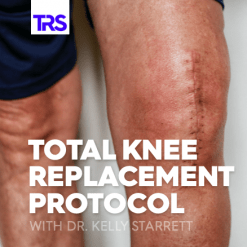Improving Total Knee Replacement Recovery Time with Dr. Kelly Starrett
Kelly Starrett’s Step-by-Step Guide For TKR Pre-Op Prep & Post-Op Recovery
In 2021, Kelly Starrett, DPT underwent Total Knee Replacement (TKR) surgery. In the videos below, he breaks down the key components for how he was able to maximize his knee replacement recovery time, relieve pain without medication, and get back to function a lot faster than most post-op patients do.
Post-Op Protocol Basics:
Kelly reviews the over-arching goals for post-op recovery, including pre-op prep to help get your body into the best state possible before surgery. He highlights how H-Wave can help:
- Manage post-surgical pain with on-demand pain relief
- Manage tissue congestion in both pre-surgical and post-surgical sites
Read additional details on these two goals here.
Kelly reviews how to maximize success during the three main stages of surgery and recovery:
- Pre-Operative Preparation
- Post-Op Care Immediately After Surgery
- Long-Term Post Operative Care
This way you can hopefully reduce the knee replacement recovery time after surgery.
Read more about these three steps here.
Pre-Surgery Prep
If you’re still debating on whether or not you want to take the surgical plunge, Kelly provides tips on how to utilize H-Wave to manage pain and symptoms of an acute injury before going into surgery.
Read more about how to manage acute pain before surgery.
As Kelly prepared for his own total knee replacement (TKR) surgery, he broke down his recovery approach in a 3-part video series to highlight:
- His Plan To Accomplish Short Term Goals
- How He Set Up His Environment To Maximize Recovery
- Understanding the Long-Term Healing Process & Timelines After Surgery
Knee Replacement Recovery Time – Know What Your Short-Term Goals Are
After trauma we often see a disconnect between the brain and muscles due to inactivity and immobility. The brain can start to be fearful of moving due to pain or congestion, which can lead to additional immobility and muscle loss. In the first video of the series, he explains how he plans to accomplish his short term goals:
- Having a plan to manage pain
- Keeping the brain-to-muscle connection intact
Read more about setting your post-op short term goals.
Setting Up Your Environment
Kelly reviews strategies on how to set up your environment so you can get the most input back into your system immediately and consistently, in order to keep the brain-to-joint and brain-to-muscle connections strong and optimize your total knee replacement recovery. He provides suggestions of tools you can have ready in your home, like the H-Wave OTC, as well as how you can do low level balance drills like they use in physical therapy.
Read more about how to set up your post-op environment.
Knee Replacement Recovery Time – Understanding Long-Term Recovery Goals
Kelly points out that THERE ARE NO FAST HEALERS…. the body is designed to heal at a certain rate and no one can faster than that. Many people can heal SLOWER than this standard rate though, based on a number of factors including pre-surgery/pre-trauma physical, emotional, and mental health, diet, water consumption, sleep patterns and more.
In the 3rd video of this series, Kelly outlines knee replacement recovery time guidelines for different levels of tissue, bone, and ligament trauma and what to expect from your body according to those timelines so you can aim to heal at the maximum rate humans are designed to.
Read more about your long-term post-op recovery goals.
Post-Surgery Care
One of the biggest impediments that prevents people from getting back to function is the congestion and swelling that builds up so quickly after trauma or surgery. This congestion creates a secondary source of pain (other than nerve or tissue pain) and can potentially extend your knee replacement recovery time. Kelly highlights a key component in his plan to manage swelling immediately post-op.
Read more about how to control post-op swelling here.
Targeting Both Sources of Post-Op Pain
Kelly reviews typical pad placements and settings for the H-Wave to target the two main causes of post-op pain:
- Nerve Pain – getting on-demand pain relief on the spine or through the joints to achieve a long-lasting analgesic effect
- Pain Due to Swelling & Congestion – how to flush targeted areas of the body or have a more global flush to clear out the waste and bring blood & nutrients into the area(s)
He also reviews some alternate pad placements to use if the standard placements aren’t getting the desired effect, or depending on where the surgical site is and what areas of the body are accessible.
Learn more about how to target these two types of post-op pain.
Want More of Kelly’s Total Knee Replacement Journey?
Watch Kelly’s Full Video Playlist on Everything Surgery-Related
For even more guidance on your total knee replacement journey, you can purchase Kelly Starrett’s Total Knee Replacement Protocol HERE. After going through this protocol, you should be able to:
- Develop a pre-surgery plan that will set you up for success post-surgery
- Understand what surgery day will look like
- Actively desensitize and decongest tissues and decrease symptoms during recovery
- Create behaviors that optimize your tissues for speedy healing
